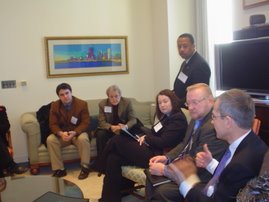Architectural Education, Training & Practice:Adopted January 2009
Introduction:
Just over 130 years ago in 1878, formal academic training became a requirement to the traditional apprenticeship system for architects in the United States. Prior to the nineteenth century, architects had studios or ateliers and education varied from formal settings such as that at the Ecole des Beaux Arts in France to the informal draftsmen/apprenticeship system that would occur in the architect’s office or studio. Also of note, primarily in England during the eighteenth and nineteenth centuries, were gentlemen architects, who were architects with private means.
Today the career of an American architect occurs in three distinctive phases, although overlap occurs in the transition between the phases as the individual develops from student to practicing professional. The phases are: Education, Internship, (which includes Examination and Licensure), and Practice (which includes Mentorship and Continuing Education).
Compared to other countries like England, France and Germany, in the United States there is a gap between professional and the academic or educational requirements.(1) In the United States, often the academics are criticized by those in practice for not preparing the students for the “real world.” The reason for this criticism is complicated, but at its root is the fact that the professional associations in the United States as compared to those in Europe are not as well integrated into the architectural education process. In Europe the professional associations simply have more say in how architects are trained at the university level. (England is an extreme example of this where the Royal Institute of British Architects (RIBA) handles both licensure and the credentialing of schools.)
The National Architectural Accrediting Board (NAAB) is the sole agency authorized to accredit professional degree programs in architecture in the United States. NAAB is comprised of the following collateral organizations, Association of Collegiate Schools of Architecture (ACSA), American Institute of Architects (AIA), American Institute of Architecture Students (AIAS), and the National Council of Architectural Registration Boards (NCARB). NAAB sets the criteria for the schools and is thus the current vehicle for improvement and change.
The five collateral organizations work together in a relationship that is most easily described as a system of checks and balances. Each organization oversees its particular interest, while containing members and liaison representatives of other organizations on its Board of Directors. While AIA Illinois realizes the need to oversee the credentials of licensure and academic accreditation, we believe these duties should be held by separate governing entities. In this way, the collaterals must work together to agree upon the greatest outcomes to the entire education, experience, and examination processes.
Principles/Position
AIA Illinois believes education and practice should be a seamless continuum for assuring that the future of our profession is in capable hands.
The AIA supports the interdependence of practice and education as elements of the profession that, when integrated, enable students, educators, and practitioners to obtain and maintain the knowledge and skills needed to enter and fully participate in the profession, and to achieve design excellence in service to society.
Further the profession should be regulated. The privileges and responsibilities of practice should be extended only to those architects who demonstrate through education, experience, and examination that they are ethically, intellectually and technically prepared.
AIA Illinois supports a professional degree from a program accredited by the National Architectural Accrediting Board (NAAB) as the most appropriate minimum threshold for educational training. Alternative educational pathways in lieu of a NAAB accredited degree should be considered to fulfill educational prerequisites to licensure on an individual candidate basis. (2)
Phase 1: Education
AIA Illinois applauds Universities and Institutions that are working toward curricula that seek to emphasize and complement the many facets of the dynamic world of architectural practice. (3)
AIA Illinois supports programs that formally include curricula for the allied professionals required by the ever increasingly complex field of architecture.
Sustainable Design and Practices:
In keeping with AIA Illinois’ mission to “advocate a livable built environment by advancing the profession of architecture in Illinois” we support Universities and Institutions that are integrating sustainability into their curricula.
College Recruiting:
AIA Illinois encourages Universities and Institutions to be clear when recruiting students, in regards to their own accreditation, explaining the path towards licensure and how their program fits in that path.
Phase 2; Internship (Encompassing Intern Development Program, Examination and Licensure)
Intern Development Program
AIA Illinois supports a comprehensive internship program with measurable qualitative training criteria. The Intern Development Program (IDP) should provide interns with the diverse training and experience in architecture essential to the preparation for licensure. (4)
AIA Illinois supports a system that is reasonable and expeditious for documenting the intern experience.
AIA Illinois supports initiatives that will encourage architecture professional degree graduates to complete the IDP process and sit for the examination without delay.
Internship Compensation AIA Illinois supports the concept that firms should properly compensate all employees (including students) in compliance with federal wage laws.(5)
Architect Registration Examination (ARE)
AIA Illinois maintains that passing of the Architect Registration Examination (ARE) is the only acceptable threshold for fulfillment of the examination requirement for licensure. The ARE should test candidates for public protection competencies gained through a combination of professional degree education and practical experience, once the candidates meet the licensing requirements of the local jurisdiction. The AIA, through its members and chapters, should encourage emerging professionals to complete the examination.
Timing of Exam
AIA Illinois supports regulations allowing architectural graduates with professional degrees to sit for the ARE upon graduation from an accredited program and currently enrolled in the Internship Development Program.
Licensure
The AIA maintains that passing of the Architect Registration Examination (ARE) is the only acceptable threshold for fulfillment of the examination requirement for licensure. The ARE should test for public protection competencies gained through a combination of professional degree education and practical experience, of candidates once they meet the licensing requirements of the local jurisdiction. The AIA, through its members, should encourage emerging professionals to complete the examination. The profession and society will be best served by a growing number of licensed architects. (2)
Titles:
The AIA IL supports protecting the public by reserving the use of the term “architect” and its derivative forms to those individuals licensed as architects in accordance with the Architectural Practice Act of Illinois. In addition, the AIA supports the term “architectural intern” for students and graduates of NAAB-accredited degree programs.
Phase 3: Practice
Mentoring by the Licensed Professional
AIA Illinois encourages its members to recognize and nurture emerging professionals as they advance through all stages of their professional experience, beginning with professional education and progressing through internship and licensure.
AIA Illinois supports Firms that formalize the mentorship program within their offices.
Mandatory Continuing Education
AIA IL endorses AIA Nationals position that maintains that each jurisdiction should mandate a minimum amount of continuing education for architectural licensure renewal. The American Institute of Architects further advocates that any jurisdiction considering continuing education for re-licensure accept The American Institute of Architects continuing education requirement for membership and record keeping system as a means of fulfilling the jurisdiction’s requirement. (2) The Illinois Department of Professional Regulations conforms to this policy.
Goals:
1. Have a diverse group composed of people with passion and potential pursue the profession of architecture.
2. Provide clear and reliable process for the development of talented architects who at the end of the process are qualified to impact the built environment in a positive way.
3. Education, internship and practice be integrated, so as to produce a steady resource of well trained architects.
A. Have educational institutions offer a balance of quality educational programs that provide the appropriate role in the overall development of future design professionals and community shapers.
B. Improve the internship documentation process, so that it produces well rounded examination candidates and is not burdened in bureaucracy.
4. Have individuals, members and firms make on-going contributions to the development of quality architectural professionals through mentoring others and continuing their own education efforts.
Calls to Action: (In no order of preference)
1. Call to Architects/AIA Membership:
-Members of the Profession to consistently address a diverse group of youths, providing exposure, advocacy of architecture, design and inspiration for those interested in it.
-Professionals to create a culture of respect and nurturing for students and interns in professional offices.
-Professionals, when proximity allows to participate in academic programs, teach or critique
-Individual professionals to provide mentorship to architectural interns, a key factor in their development.
-Students and interns to approach the pursuit of licensure with diligence and perseverance.
2. Call to Legislature/Regulating Authorities:
-The Department of Professional Regulations and the Joint Committee on Administrative Rules to advance the measures allowing degree holders with National Council of Architectural Registration Board (NCARB) applications to sit for the Architectural Registration Examination
-National Council of Architectural Registration Board (NCARB) to provide a system for efficiently and reliably documenting the intern experience.
3. Call to Academia / Allies / Collaterals
-Educational Institutions to provide clarity of their architectural program and its role in the professional quest.
-Colleges and universities within the state to include the topic of integrated practice as part of their curriculum.
-Promote diversity within schools to foster a foundation for greater diversity in the profession
-Integrate sustainable practices into the architecture curricula
Notes:
1. A History of Architectural Education in the West
http://www.archsoc.com/kcas/Historyed.html#four2. Language directly from National AIA Policy statement
3 Programs that “close the gap”:
University of Cincinnati:
http://www.uc.edu/propractice/University of Illinois – Chicago (Circle)
4 NAAB does not require the internship
5. Background: From AIAS - It had been considered, in the past, appropriate to "hire" students or recent architecture graduates to work for an architecture firm for little or no compensation until they had obtained a sufficient amount of experience. This practice ignores and belittles the contribution that each participant adds to an architecture project. Each team member deserves to be paid or given academic credit for all work performed at a firm or office. The AIAS denounces those firms that do not properly compensate their employees. The AIAS supports the efforts of interns who refuse to work for a firm that knowingly does not compensate interns in full compliance with the law. Further, AIAS will not invite partners of such firms to speak at national or chapter AIAS events nor participate in competition juries. History: Adopted 7/93, Amended 7/04
Informational References:
1. History of Architectural Education:
*A History of Architectural Education in the West
http://www.archsoc.com/kcas/Historyed.html#fourhttp://en.wikipedia.org/wiki/Architecture#Origins_and_the_ancient_worldInformational Note: (Illinois was the first state to require licensure in 1897.)
2. Collateral Organization Websites:
National Architectural Accrediting Board
http://www.naab.org/3. Other AIA Position Statements on Education:
National AIA Positions on Education:
http://www.aia.org/SiteObjects/files/Public_Policy_Directory_revised_1205.pdfWashington State AIA: Position on Architectural Education:
http://www.aiawa.org/ps/ps_arched.html4. Internship Topics:
-6 Month Rule”
http://www.aia.org/nac_n_080807_6monthrule-ARE+IDP Timing
http://blog.aia.org/nac/2007/07/what_will_the_idp_look_like_fo.htmlAIA Position on ARE Timing:
https://detmail.hedev.com/exchweb/bin/redir.asp?URL=http://www.aia.org/SiteObjects/files/ARE%2520Timing%2520Issue%2520Brief%25202007.pdfWork Group Members/Contributors:
Mike Rogers, AIA, Frank Heitzman, FAIA, Robert Selby, FAIA, Susan King, AIA, Chris Cochran, AIAS, Ryan Murphy, AIAS, Norman Loch, AIA, Meggan Lux, AIA, Michael Newman, AIA, William Worn, AIA, Gaines Hall, AIA, Ameera Ashraf O’Neil




